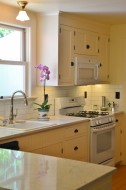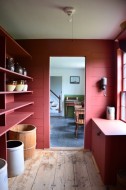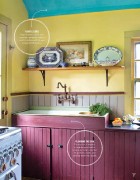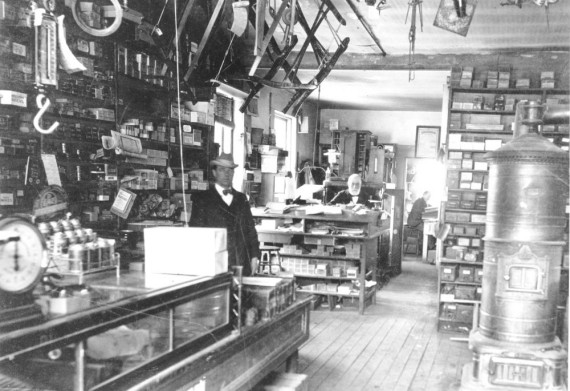
A Maine Italianate
March 18, 2013
A careful restoration will be invaluably aided if you let the building be your guide. Paying attention to those sometimes subtle tells - allows the structure to voice its opinion - lets an old building speak its mind. Sometimes that conversation can take you beyond the nut and bolts to real events and history. One of our current projects - the complete restoration of over thirty windows in an 1895 Italianate - provided just such a twist.
The modest though stately structure sits a little bit more than a stone's throw from the St. Croix River in Calais, Maine, with views of St. Stephen, Canada. Its architectural details are simpler than other 'high style' examples leading our client to affectionately refer to his boyhood home as a "Maine Italianate."
Inside, the home is a well-kept masterpiece; tastefully and amply furnished with period pieces and wallpapers, as well as curios and objets d'art of all shapes and sizes. Some of the furniture pieces were handcrafted locally in the nineteenth century by prominent Calais and St. Stephen cabinet makers. We were called in to deal with some of the failing frosting on this marvelous Devil's food cake.
Maine winters can be tough on old windows and over the course of 118 years, a lot can happen. Poor workmanship, neglect, water penetration and broken panes, present a host of problems; still its' surprising what an old growth cedar, mortise and tenon, nineteenth century window sash can take.
Many opt to just chuck the old windows in the dumpster, substituting them with modern replacements. These can be of a pricey, high end variety, double-paned thermal with real wood, or more likely the ubiquitous extruded vinyl. What is not well understood is that with a good set of storms, the original nineteenth century sashes are in most cases superior to anything on the market today for quality and durability, as well as their insulating ability - and the cost of restoration is comparable to the most economical replacements. The result is a sound quality product, from a bygone era, that preserves the historic fabric of the old building.
We like to remove the paint and glazing and take the glass out. We label the often original wavy and bubbled glass so we can put it back in its rightful spot- someone peering out their favorite window might miss those familiar imperfections. Generally any problems can be fixed at this point - pulling joints tight, fixing failed material with a Dutchman, brushing on linseed oil for dried or weathered wood - every window has a different set of problems; though in this case they all looked pretty good.
After everything is sanded it's time for priming and a coat of finish paint. Then we glaze the glass in place. We special order our glazing as we don't like the store bought type. A spring operated driver that shoots diamond shaped points, speeds up the process. In the old days when sashes were handmade on-site, the carpenter/glazier would cut these points by hand in a triangle from a piece of tin and push them in with a chisel. We have collected a stash of these tiny antiques (some 200+ years old) which we keep in a jar in our shop.
Once the glazing has skinned over we prime that, let it dry, topcoat that, then add a second coat of paint to the whole sash. With a complete overhaul the windows look like new - right down to the gleaming Victorian sash locks. These had been covered with layers of paint, obliterating their details and making them wholly inoperable.We didn't know quite what to expect until we stripped that first sash lock (we boiled them on the stove) - what we found was something quite special. The Eastlake styled sash lock base was cast iron, but the locking lever was solid bronze with wonderfully ornate patterning throughout.
Several were missing or broken, so we initiated an online search for some antique replacements. We found just what we needed - all an exact match. These patented, 1886, Eagle Claw sash locks were made by the H. B. Ives Company of New Haven, Connecticut. The company was founded by Hobart B. Ives, the sash lock's inventor, in 1876. The 'arm' is a feathered wing that locks into a claw on the 'keeper'. These stunning little jewels, now freed of their paint are the perfect window dressing.
Last week we installed a batch of the restored windows, complete with new sash weight cords, then removed the next batch which we brought to our workshop for their centennial overhaul. That's when we happened on our twist. It is not too common to find markings on old windows, so one sash in the group stood out. There on its side was stenciled C.B. & Co., Calais. We'd seen this sort of mark before; C.B. & Co. was probably a local supplier and the likely 19th century source for our project home's - sashes, doors and hardware.
I immediately emailed our go-to guy for Robbinston and Calais history, Al Churchill, to see what he might know. An attorney and President of the St. Croix Historical Society, he has at his fingertips extensive knowledge and a large archive of historic local photographs. Within an hour we had our answer. Al generously and nimbly emailed us some amazing images, a newspaper ad and a business listing for a venerable nineteenth century Calais institution; all fodder for the sensitive restorer's imagination.
C. B. & Co. was known in its day as Chase Barker & Company - one of the main hardware, ship chandler and building supply firms in Calais.The shop was located on the corner of Union Street and Hog Alley. They specialized in hardware, paints, oils, blacksmith supplies as well as doors and window sashes. In their ad they boast, "the largest stock of the above goods in Eastern Maine." The listing that follows tells their story;
CHASE, BARKER & CO, dealers in Hardware, Iron and Steel, Paints. Oil Glass, etc., Calais, Me., and St. Stephen, N.B. - Since the enterprise conducted under the firm name of Chase, Barker & Co., was founded in 1850 by Messrs. Chase & Berry there has been various changes in the firm. In 1868 the present firm name was assumed. Mr. Chase is now deceased and the members of the firm are Mr. John Barker of Calais, Mr P. M. Pirington of Exeter, N.H., and Mr. Elwell Lowell of Wiscassett, Me. All the gentlemen are well and favorably known in Calais and vicinity, Mr. Pirington in particular, he having been mayor in 1887. The premises in use which have been occupied by the members of this firm since 1851 are located on Union street, and comprise three floors and a basement, each being 40x60 feet in dimensions, besides a two story storehouse on the wharf in the rear.
The firm also conduct a store at St.Stephen, N.B. three assistants being employed at the latter place. Messrs. Chase, Barker & Co. carry at each of their stores a heavy and varied stock, including hardware of all kinds, iron and steel, paints and oils, all kinds of carriage stock, doors, sashes, etc., both a wholesale and retail trade being done.The firm are in a position to quote the lowest figures to both large and small buyers and to guarantee goods they sell to prove just as represented. Five reliable assistants are employed at their Union street store. All orders are given prompt attention and are accurately filled and delivered.
(click photo to view larger image)
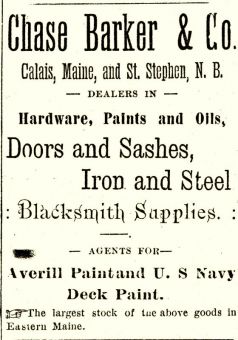
|
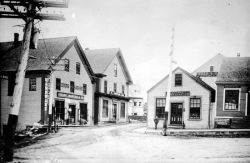
|
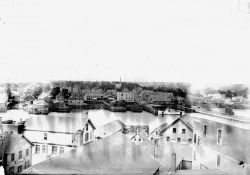
|
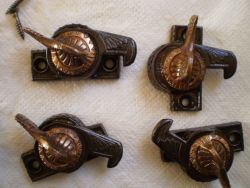
|
(comments = 1)
It's good to hear about your fine window work. I have those very same sash locks on my 1899 house here in Portland, Maine
leave a comment

fineartistmade blog
A journal about home design, gardening, art & all things Maine. Read
more...
- December 2022
- November 2022
- October 2022
- November 2021
- May 2020
- October 2019
- August 2019
- July 2019
- September 2018
- April 2018
- December 2017
- August 2017
- June 2017
- May 2017
- December 2016
- August 2016
- July 2016
- April 2016
- November 2015
- June 2015
- May 2015
- March 2015
- October 2014
- March 2014
- February 2014
- January 2014
- December 2013
- November 2013
- July 2013
- May 2013
- April 2013
- March 2013
- January 2013
- December 2012
- November 2012
- August 2012
- June 2012
- April 2012
- March 2012
- February 2012
- January 2012
- December 2011
- October 2011
- August 2011
- July 2011
- June 2011
- May 2011
- April 2011
- March 2011
- February 2011
- January 2011
- December 2010
- November 2010
- October 2010
- September 2010
- August 2010
- July 2010
- June 2010
- May 2010
- My Scandinavian Home
- Daytonian in Manhattan
- {frolic!}
- I Married An Irish Farmer
- Smitten Kitchen
- The Curated House
- even*cleveland
- Mary Swenson | a scrapbook
- Ill Seen, Ill Said
- Gross & Daley Photography
- Remodelista
- Abby Goes Design Scouting
- Mint
- the marion house book
- 3191 Miles Apart
- Svatava
- Katy Elliott
- Poppytalk
- Kiosk
- decor8
- KBCULTURE
- Lari Washburn

